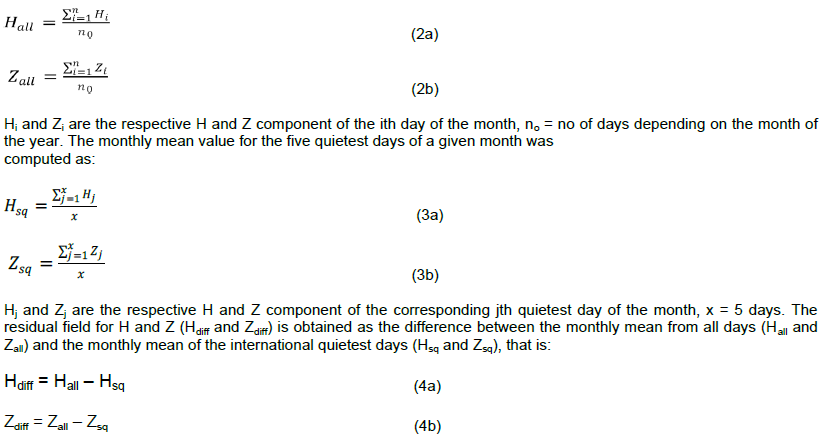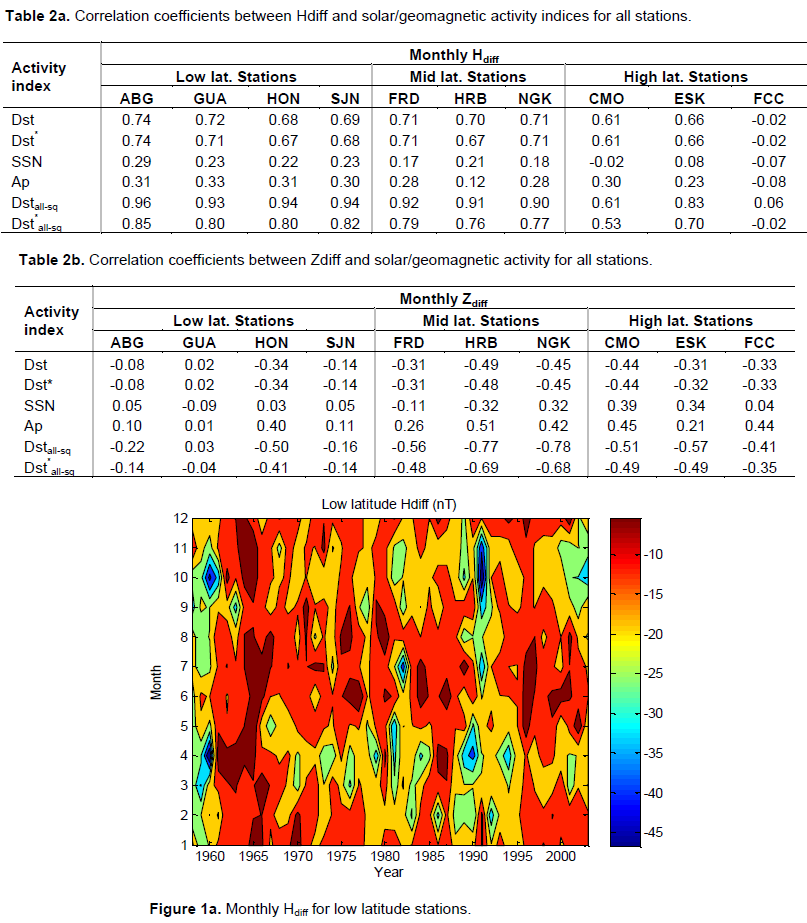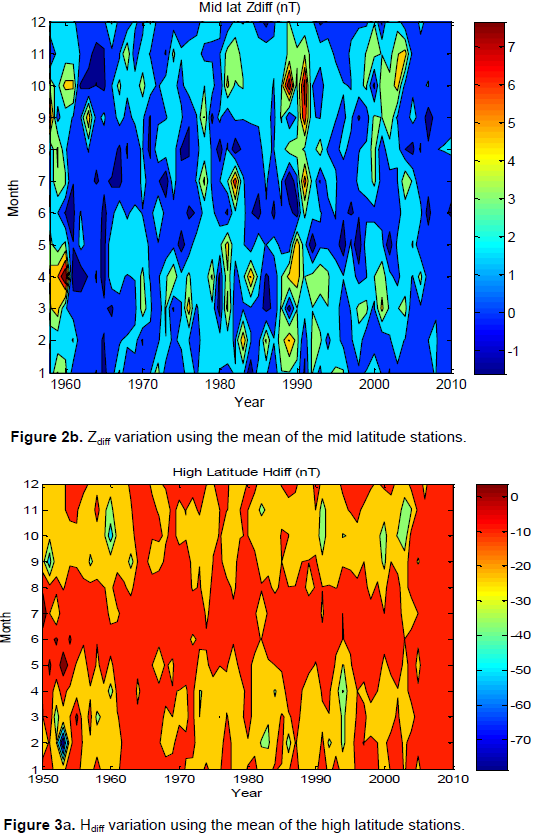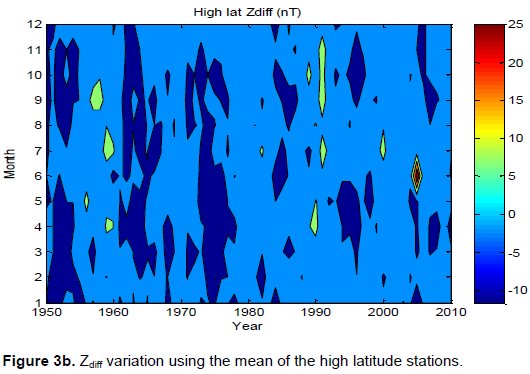ABSTRACT
The semi-annual variation of the residual H and Z components of geomagnetic field was studied by analyzing magnetograms with sixty-one years data. Mean monthly residual H- and Z-component field (Hdiff and Zdiff) variations were computed using appropriate technique. Semi-annual variation exhibited Hdiff peaks in the equinoxes, which for low latitudes, was higher during March/April than in September/October. In the mid and high latitude stations also, Hdiff exhibited clear semi-annual variation albeit with less intensity during the equinoxes. Mid latitude broad peaks in the said variation suggest longitudinal asymmetric contributions to the ring currents. Zdiff in all the latitudes exhibited greater asymmetry in its distribution in comparison with Hdiff. Zdiff variation was largest in the high latitude regions, showing strong solar activity dependence. It is suggested that asymmetric component of the ionospheric coupling to the magnetospheric current may be responsible for the observed irregularities in the low- and mid-latitude Zdiff semi-annual variation, while the East-West and West-East currents in the auroral oval region may be modulating the ring current effect on residual field at high latitudes.
Key words: Geomagnetic field, magnetograms, H and Z components.
Solar activity refers to the natural phenomena occurring within the magnetically heated outer atmospheres in the sun throughout the solar cycle. This activity takes the form of solar wind acceleration, flux emergence, light and energy particles released from the sun such as solar flares, coronal mass ejection or solar eruptions, and coronal heating; as well as sunspots which are one of the most commonly noticed forms of solar activity. Geomagnetic activity can be separated into auroral magnetic activity and magnetic substorms. Auroral magnetic activity involves the enhanced auroral light displays, currents, and magnetic perturbation associated with times when favorable magnetic coupling causes enhanced plasma flows down the cusp field lines into the auroral regions. Magnetic substorms occur, however, when the magnetosphere is loaded with excess energy during a period with sustained southwards interplanetary magnetic field (IMF-Bz). These geomagnetic activities constitute a major part of the monthly disturbances in the geomagnetic field and they are generally quantified by the geomagnetic storm time index – Dst, and the average planetary disturbance index – Ap. The Ap index represents the daily intensity of planetary magnetic activity as seen at sub-auroral latitudes, while the Dst measures the ring-current magnetic field based on hourly average values of the H component recorded at four low latitude observatories after subtracting the average square and the permanent field from the disturbed magnetic field (Fares Saba et al., 1997).
The measured magnetic field on the surface of the earth is generally linked to three sources: i) main field which is generated by hydrodynamic dynamo system in the Earth’s core, ii) current systems in the ionosphere and magnetosphere, and iii) magnetized rocks in the Earth’s lithosphere. The magnetospheric and ionospheric currents are usually regarded as the external magnetic field components of the measured field at the surface of the Earth. These external fields are also responsible for induction currents at the mantle of the Earth which further modify the measured field.
Many authors have attempted to separate the symmetric and asymmetric contributions to the magnetospheric ring current using spherical harmonic analysis (Banks, 1969; Xu et al., 2015), wavelet analysis (Mendes et al., 2005; Xu et al., 2009), and ion density variations (Daglis and Axford, 1996). Most of these studies have investigated the symmetric ring current using the well-known signature of Dst during geomagnetic storms. The ring current is an electric current carried by charged particles trapped in the magnetosphere. It is caused by the longitudinal drift of energetic particles. The ring current provides the geomagnetic conditions for magnetic storms to settle down (Mendes et al., 2005). It dominates at middle and low latitudes, and a system of ionospheric electrojet currents flowing in the auroral oval dominates at higher latitudes. The ring current is ever present and its long term structure is detectable in the monthly mean geomagnetic field essentially leading to weaker mean geomagnetic field during disturbed times and stronger field during quiet times. Forbush and Beach (1967) first introduced the concept that departures of quiet and disturbed X component of the geomagnetic field (XRC(Q) and XRC (D), respectively) maintain a fixed ratio to each other throughout the solar cycle such that;

Thus by equating XRC(D)-XRC(Q) with X(D-Q) the absolute ring current field can be estimated from observatory data, once an appropriate value for k is found. Furthermore it was suggested that k is a universal constant. This implies that the geometry of the ring current field is the same throughout the solar cycle and the same on quiet days and disturbed days. The difference measures the absolute strength of the ring current and should define the Dst connection to monthly and annual means. In the present study, Equation 1 is applied and the North component (X) replaced with H-component and monthly mean computed for all days to reflect mean strength of the ring current for the particular month.
The objectives of this study are to investigate the variation of the residual field on seasonal and annual scales in low-, mid- and high latitude stations and examine them for indications of possible anomalous behavior.
The magnetic data used for this study was obtained from 10 observatories within the northern hemisphere, cutting across low-, mid- and high-latitudes. Two of the stations (Sanjuan, and Honolulu) were used in computing Dst (disturbance storm time) index. Dst index is a function of the current inside and on the boundary of the magnetosphere, and it measures the ring-current magnetic field based on hourly average values of the H component. The data was originally in hourly time resolution and was converted to daily values covering the year 1950 to 2010 (61 years). Data presented in X and Y were converted to H since the interest is in H and Z components, where X, Y, H and Z represent northerly intensity, easterly intensity, horizontal intensity and vertical intensity, respectively of the geomagnetic field. The geomagnetic field data is provided by the world data center (WDC) for geomagnetism Kyoto, Japan (Table 1). The daily Dst, average planetary disturbance (Ap) index, solar wind (SW) velocity and density, sunspots number (SSN) are provided by OMNIWeb. Data was selected based on the criterion of length and continuity of series of the geomagnetic field components. Monthly mean from all days in a given month for H-component and Z-component denoted by Hall and Zall was computed as:


Hdiff and Zdiff are the residual fields which measure the absolute strength of the ring current in addition to other external and internal sources of geomagnetic field (excluding the solar daily variation) for the month assuming that the ring current geometry does not change much over monthly scales.
The linear correlation coefficients between the monthly mean Hdiff and Zdiff for all the stations and some solar (SSN)/geomagnetic (Dst,Ap) activity indices is shown in Tables 2a and 2b, respectively. The mean of the low, mid and high latitude stations were taken and plotted over the period of years of this study to obtain the semi-annual Hdiff and Zdiff variations. These plots are shown in Figures 1, 2 and 3 respectively.
Correlation analysis
A linear association was assumed between Hdiff and solar activity. This is a fair assumption considering that both the annual and semi-annual variations are controlled by solar activity which in turn controls geomagnetic activity. Table 2a is the linear correlation coefficients for Hdiff against solar (SSN) and geomagnetic (Dst and Ap) activity indices. For high latitude stations, the correlation is not as strong but is generally > 0.60 for most high latitude sub-aurora stations except for FCC which is an aurora station. The correlation appears to be latitude dependent and could lead to a means of reproducing mid and low latitude fields from derived Dst measurements. The total contribution of the induced field is about 11 to 15% of the statistical association and this is observed in all the stations used in this study. These observations are consistent with wavelet and cross spectra analysis observations by Xu et al. (2009), suggesting that the slow-time varying component of the ring current are largely globally symmetric. The solar activity index (SSN) did not correlate well with the Hdiff in all the stations used. This poor correlation may not be unconnected with the indirect solar forcing of the ring current leading to significant semi-annual variation in the geomagnetic activity with disturbance field at each station.
Correlation between Zdiff and Dstall-sq for all stations was higher than that for Zdiff vs Dst*all-sq (Table 2). The low latitude stations ABG, GUA and SJN showed weak correlation (<0.20). This low latitude observation can be explained by the weak low latitude Z-component field when compared with the mid and high latitudes Z field. The symmetric ring current does not have a significant component in the Z axis but in the North-South direction. The Zdiff showed a weaker correlation with SSN when compared with the geomagnetic activity index in the mid-latitudes and high-latitudes. Variability in the high latitude is expected to depend on solar activity since more particles are injected into the open magnetic field in the auroral oval which significantly modifies the magnetic field measured there. The observed increase in Zdiff during the equinox is evidence of the enhanced westward polar electrojet during enhanced geomagnetic activity. The solar quiet day effect on the Dst-related magnetic variation is dominant in the mid latitude when compared with low and high latitude. Removing the induced field component however reduces this correlation in a nearly uniform manner for all the stations considered. The constantly negative correlation for all stations shows that the observations are consistent with an inverse relationship between the symmetric ring current and the main magnetic field.
Hdiff and Zdiff variation
The semi-annual residual field variation in the low latitudes (obtained as the mean Hdiff from the four low latitude stations (ABG, GUA, HON, SJN)) is shown in Figure 1a. There is a visible semi-annual peak around March/April and September/October which is similar to observations of earlier authors, for example, Wardinski and Mandea (2006). The semi-annual variation is more prominent during years of solar maximum activity. For solar minimum years, the semi-annual peak is greater in March/April than in September/October. The usual prominent semi-annual peaks observed during solar maximum years was missing in the 1970 to 1971 peak, possibly connected with earlier reports of marked diminutions in sunspots and 2800 MHZ flux which took place in 1970 and 1971, respectively, and were accompanied by concomitant decreases in flare-occurrence (Dodson and Hedeman, 1975).
The usual semi-annual variation observed in the H component is a little more complicated in the low latitude Zdiff as shown in Figure 1b. The Zdiff tend to exhibit positive values around March-April-May and September-October-November which is expected for a ring current flowing westward over the equator. The range of variation is between -4 to 5 nanotesla (nT). Solar-cycle variation is not very prominent even for periods of very high solar activity. This observation is likely a result of the dominance of the effect of geomagnetic activity on the Z component even though the statistical association between Zdiff and Dst (or Dstall-Sq) is weak for most low latitude stations. The relative shift in the time of the equinoctial peaks is currently unexplained.
The mid latitude Hdiff variations exhibited semi-annual peaks between February - April and September - November as shown in Figure 2a. The broad peaks suggest that longitudinal asymmetric contributions to the ring currents are dominant at the mid latitude. During the maximum and declining phase of all the solar cycle covered in this study and especially cycle 20 and 22, the semi-annual peaks are broad and generally spread into the adjacent maximums. This is an evidence that Dst-related disturbance is more symmetric in the response to the North-South migration of the ring current when compared to the fluctuating solar activity.
Variations in line with solar cycle were not observed in the mid latitude Zdiff (Figure 2b), except for the deep solar cycle minima in 1962 to 1965 and 2004 to 2008. The equinoctial peaks in April and October are spread toward earlier months and quite complicated by other current systems coupled to the ring current. A slightly greater peak value is observed around the equinoxes in the mid latitude when compared to the low latitudes Zdiff. The range of Zdiff variation is between - 1nT and 7nT. Asymmetric sources are likely a significant component of the Zdiff variation. Mid latitude ionospheric current contributions to the semi-annual variation may be a leading candidate for the asymmetric source.
Semi-annual peaks were quite distinct and prominent in the high latitude, showing minimum Dst-related disturbance Hdiff in the summer months as shown in Figure 3a. The extended minimums of cycle 19 and 23 were evident in the plot. The Dst-related disturbance in this region may be enhanced by sub-storm Westward polar electrojet since the symmetric peaks in the March-April and September-October are distinct irrespective of the usual presence of strong asymmetric component in the high latitudes. This observation supports the understanding that the partial ring current seems to develop and decay earlier than the symmetric ring current, which is responsible for the worldwide uniform decrease in Hdiff observed in all the stations used in this study independent of latitude.
High latitude Zdiff variations (Figure 3b) show very significant solar cycle dependence. Positive Zdiff occur during solar maximum years while negative Zdiff occur during the period of minimum solar activity. The range of the variation in Zdiff is from -I0nT to 25nT. The semi-annual variation is not very clear in this region. The high values of Zdiff are a confirmation of the Westward current dominance observed in the Hdiff plot.
The present study showed that the internal induced field contribution to the Dst-related disturbance is significant and quite symmetric in the low- and mid-latitudes, and weaker in the high-latitude. Dst*all-sq may be potentially useful for reproducing the magnetic field in mid- and low-latitudes. Hdiff semi-annual variation in the low latitude is more prominent during years of maximum solar activity. For solar minimum years, the semiannual peak is slightly greater in March/April than in September/October. The Hdiff enhancements observed in the mid- and high-latitude during March / April and September / October were generally more intense than those observed in the low latitudes. Zdiff is largest in the high latitude and showed a tendency of being more negative during periods of solar minimum as compared with the periods of solar maximum. The westward auroral current compliments the ring current during periods of high solar activity leading to a positive Zdiff and an observable semi-annual variation in the Hdiff. Other asymmetric sources (like the field aligned current) and regional tendencies in conductivity profiles may also be contributing to this variability.
The authors have not declared any conflict of interests.
REFERENCES
|
Banks RJ (1969). Geomagnetic variations and electrical conductivity of the upper mantle. Geophys. J. R. astr. Soc. 17:457-487.
|
|
|
|
Daglis IA, Axford WI (1996). Fast ionospheric response to enhanced activity in geospace: ion feeding of the inner magnetotail. J. Geophy. Res. 101: 5047-5065.
Crossref
|
|
|
|
|
Dodson HW, Hedeman ER (1975). Comments on the course of solar activity during the declining phase of solar cycle 20 (1970-74). Sol. Phy. 42(1):121-130.
Crossref
|
|
|
|
|
Fares Saba MM, Gonzalez WD, Gonzalez AI (1997). Relationship between the AE, Ap and Dst indices near solar minimum (1974) and at solar maximum (1979). Ann. Geophys. 15:1265-1270.
Crossref
|
|
|
|
|
Forbush SE, Beach L (1967). The absolute geomagnetic field of the equatorial ring current. Carnegie Institution Yearbook 65:28-36.
|
|
|
|
|
Mendes O, Domingues MO, Da-costa C, De-Gonzalez ALC (2005). Wavelet Analysis Applied to magnetograms: Singularity detections related to geomagnetic storms. J. Atmos. Sol. Terrest. Phys. 67(17):1827-1836.
Crossref
|
|
|
|
|
Wardinski I, Mandea M (2006). Annual and semi-annual variations of the geomagnetic field components analysed by the multi-taper method. Earth Planets Space 58:785-791.
Crossref
|
|
|
|
|
Xu D, Chen H, Gao M (2015). Observed geomagnetic induction effect on Dst-related magnetic observations under different disturbance intensities of the magnetospheric ring current. Earth Planets Space. 67:15.
Crossref
|
|
|
|
|
Xu Z, Zhu L, Sojka J (2009). Wavelet cross-spectrum analysis of the ring current using magnetic records from multiple low latitude stations. J. Geophys. Res. 114:A5.
Crossref
|
|






